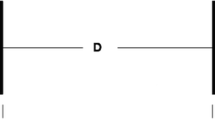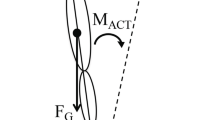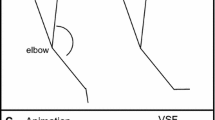Abstract
In order to effectively switch between tools, an actor must re-calibrate perceptual-motor control appropriately for the new tool’s kinetic properties. This study explored changes in perceptual-motor control in response to switching to a tool of a different weight when performing a complex control task with moving objects. In Experiment 1, 30 participants were each randomly assigned to one of three groups in a baseball batting simulation: a standard group that always used the same bat weight (1.08 kg), a Lighter group that switched from the standard bat to a 0.79 kg bat, and a Heavier group that switched from the standard bat to a 1.36 kg bat. For both the Heavier and Lighter groups, temporal swing errors were significantly larger (as compared to the standard group) in the first block of trials following the bat change. Both groups re-calibrated quickly: within 5–10 trials after the bat change there were no significant difference between the groups. Analysis of swing kinematics indicated that the two change groups used different means for re-calibrating perceptual-motor control: the Lighter group altered swing velocity while the Heavier group altered swing onset time. In Experiment 2, when batters switched from a 0.79 kg bat to a 1.08 kg bat, perceptual-motor calibration depended on the recommended bat weight for each participant (Bahill and Freitas in Ann Biomed Eng 23:436–444, 1995): batters with a heavier recommended weight altered swing velocity while batters with a lower recommended weight altered onset time. The strategy used for perceptual-motor recalibration and time required to re-calibrate in a complex motor task is dependent on the action boundaries of the actor.








Similar content being viewed by others
Notes
Fajen (2007) conducted a related study on perceptual-motor re-calibration in the task of braking to avoid a collision. In this study, the strength of the brake was suddenly changed (unbeknownst to the participant). Although this study has some important implications for the present work we do not consider it to be the same type of re-calibration process because a brake is not a tool in the same sense.
References
Bahill AT, Freitas MM (1995) 2 Methods for recommending bat weights. Ann Biomed Eng 23:436–444
Bahill AT, Karnavas WJ (1993) The perceptual illusion of baseballs rising fastball and breaking curveball. J Exp Psychol Hum Percept Perform 19:3–14
Bahill AT, LaRitz T (1984) Why can’t batters keep their eyes on the ball? Am Sci 72:249–253
Bingham GP, Schmidt RC, Rosenblum LD (1989) Hefting for a maximum distance throw—a smart perceptual mechanism. J Exp Psychol Hum Percept Perform 15:507–528
Bongers RM, Smitsman AW, Michaels CF (2003) Geometrics and dynamics of a rod determine how it is used for reaching. J Mot Behav 35:4–22
Bongers RM, Michaels CF, Smitsman AW (2004) Variations of tool and task characteristics reveal that tool-use postures are anticipated. J Mot Behav 36:305–315
Brashers-Krug T, Shadmehr R, Bizzi E (1996) Consolidation in human motor memory. Nature 382:252–255
Brouwer AM, Brenner E, Smeets JBJ (2000) Hitting moving objects—the dependency of hand velocity on the speed of the target. Exp Brain Res 133:242–248
Carello C, Thuot S, Anderson KL, Turvey MT (1999) Perceiving the sweet spot. Perception 28:307–320
Castaneda B, Gray R (2007) Effects of focus of attention on baseball batting performance in players of different skill level. J Sport Exerc Psychol 29:59–76
Cothros N, Kohler S, Dickie EW, Mirsattari SM, Gribble PW (2006) Proactive interference as a result of persisting neural representations of previously learned motor skills in primary motor cortex. J Cogn Neurosci 18:2167–2176
DeRenne C, Ho K, Hetzler R, Chai D (1992) Effects of warm up with various weighted implantations on baseball bat swing velocity. J Appl Sport Sci 6:214–218
Fajen BR (2005) Perceiving possibilities for action: on the necessity of calibration and perceptual learning for the visual guidance of action. Perception 34:741–755
Fajen BR (2007) Rapid recalibration based on optic flow in visually guided action. Exp Brain Res 183:61–74
Gray R (2002a) Behavior of college baseball players in a virtual batting task. J Exp Psychol Hum Percept Perform 28:1131–1148
Gray R (2002b) Markov at the bat: a model of cognitive processing in baseball batters. Psychol Sci 13:543–548
Gray R (2004) Attending to the execution of a complex sensorimotor skill: expertise differences, choking and slumps. J Exp Psychol Appl 10:42–54
Gray R (2006) Visual-motor control in baseball batting. In: Proceedings of the North American meeting of the international society for ecological psychology, June 22–24, 2006
Gray R (2009) A model of motor inhibition for a complex skill: baseball batting. J Exp Psychol Appl 15:91–105
Gray R, Beilock SL, Carr TM (2007) As soon as the bat met the ball, I knew it was gone: outcome prediction, hindsight bias, and the representation and control of action in novice and expert baseball players. Psychol Bull Rev 14:669–675
Held R (1965) Plasticity in sensory-motor systems. Sci Am 213:84–94
Osu R, Hirai S, Yoshioka T, Kawato M (2004) Random presentation enables subjects to adapt to two opposing forces on the hand. Nat Neurosci 7:111–112
Otsuji T, Abe M, Kinoshita H (2002) After effects of using a weighted bat on subsequent swing velocity and batters’ perceptions of swing velocity and heaviness. Percept Mot Skills 94:119–126
Regan D (1992) Visual judgements and misjudgements in cricket, and the art of flight. Perception 21:91–115
Scott S, Gray R (2007) Specificity of practice in baseball batting. J Sport Exerc Psychol 29S
Southard D, Groomer L (2003) Warm-up with baseball bats of varying moments of inertia: effect on bat velocity and swing pattern. Res Q Exerc Sport 74(3):270–276
Tong C, Wolpert DM, Flanagan JR (2002) Kinematics and dynamics are not represented independently in motor working memory: Evidence from an interference study. J Neurosci 22:1108–1113
Tresilian JR, Lonergan A (2002) Intercepting a moving target: effects of temporal precision constraints and movement amplitude. Exp Brain Res 142:193–207
Wagman JB, Carello C (2001) Affordances and inertial constraints on tool use. Ecol Psychol 13:173–195
Wang JS, Sainburg RL (2004) Limitations in interlimb transfer of visuomotor rotations. Exp Brain Res 155:1–8
Watts RG, Bahill AT (1991) Keep your eye on the ball: curve balls, knuckleballs, and fallacies of baseball. W.H. Freeman, New York
Will GF (1990) Men at work. MacMillan, New York
Acknowledgments
The work presented here represents part of the M.S. degree requirements completed by author S.S. This research was supported by NSF Grant BCS-0239657 to author R.G.
Author information
Authors and Affiliations
Corresponding author
Rights and permissions
About this article
Cite this article
Scott, S., Gray, R. Switching tools: perceptual-motor recalibration to weight changes. Exp Brain Res 201, 177–189 (2010). https://doi.org/10.1007/s00221-009-2022-z
Received:
Accepted:
Published:
Issue Date:
DOI: https://doi.org/10.1007/s00221-009-2022-z




